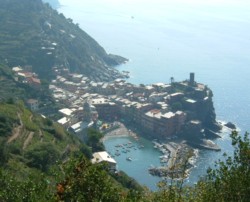‘Cinque Terre’ means ‘five lands’, and Italy’s famous Cinque Terre are five perilously-perched villages strung along a short stretch of cliffs in Liguria, at the top left of Italy’s boot. In recent years the area has become enormously popular with a particular type of tourist – American, British and German hikers with walking boots and backpacks. Crowding into the area, these cheerful visitors have ignited a thriving cottage industry of tourism, but apart from the numbers of tourists and the ‘Rooms – Zimmer – Camere’ signs everywhere, this has impacted little upon the natural beauty of the landscape and shabby ‘authentic’ charm of the fishing villages.
> Find hotels, B&Bs, apartments and villas in the Cinque Terre
Cinque Terre Tourist Information
On arrival in the area, you should hunt out an information office (easy to do; they’re right by each station and on Platform 1 at La Spezia station). If you want to set foot on the main coastal path you will need to buy a ticket. The Cinque Terre Card is valid for 1, 3 or 7 days, and entitles you to walk on the paths and use local transport (trains and buses) at no extra cost. Costs vary according to the day of the week, time of year and whether you want a card also valid on the railway from Levanto to La Spezia, so it’s very useful if you are using one of these towns as a base.
The information offices will also provide you with leaflets about the National Park, a map of footpaths (rather basic) and a train timetable (invaluable).
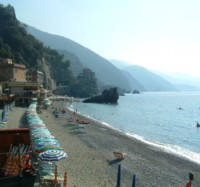
The Cinque Terre stretch of coastline is a National Park, and a Protected Marine Area, included on UNESCO’s World Heritage List. After being placed on a list of sites at risk, the Park Authority began a longterm project to revitalise the farming practices behind the characteristic hillside terraces, many of which were falling into abandonment. It also aims at a sustainable level of tourism, maintaining the character and beauty of the region. Despite the number of tourists – which is at times overpowering – the schemes appear to be succeeding admirably. There is a real sense of local identity even in the most tourist-crammed little piazze. Restaurants, bars and accommodation all have an endearingly homespun air about them, as though when the locals saw tourists coming they found a few garden chairs to stick on their terrace, handpainted a sign and began serving customers.
The Cinque Terre are (north to south): Monterosso al Mare, Vernazza, Corniglia, Manarola and Riomaggiore. Below is our brief run-down on each one.
Monterosso al Mare
Monterosso has a certain amount of history as a seaside resort, and its name may be the most familiar. It has the most beach of all the Cinque Terre, but probably the least charm. More accessible by car than the others, the result is expanses of tarmac by the seafront. There are several beach stabilimenti, where you can pay for a sunbed, and several strips of spiagga libera, where the beach is free to all.
Vernazza
Vernazza is an extremely charming small fishing port, with rooftops piled higgledy-piggledy around the little harbour and up the slopes towards a fortified tower, the Castello Doria. The small piazza by the harbour is lined with good restaurants and bars, and busy with ageing residents as well as tourists; the atmosphere is laidback and jovial, especially as the sun sets behind a distant headland and the painted buildings glow warmly in response.
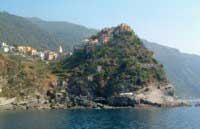
Corniglia
Corniglia is the only one of the Cinque Terre to be perched up above sea level – a steep climb if you arrive on foot. Like a pine cone, the Corniglia mound is covered in clinging roofs and painted houses. The narrow alleys are buzzing with children playing and walkers stocking up at the little alimentari, general stores. A panoramic terrace affords great views from the top of the headland, where the houses give way to giddyingly steep cultivated terraces above the sea.
Manarola
Manarola is pleasant and peaceful, with more of an air of modernity than its nearest neighbours. There’s a rocky cove which is popular with swimmers, and bars and restaurants overlooking the sea. There’s also a tiny but pretty park at the beginning of the footpath to Corniglia, where you can sit and relax.
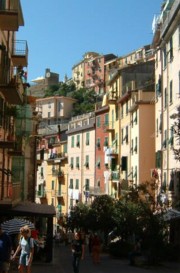
Riomaggiore
From Riomaggiore a pedestrian tunnel runs alongside the railway towards the harbour and heart of town. The town is pretty, with tall houses marching up the hill away from the sea; all painted pastels and green shutters. There are plenty of eateries of all kinds.
Cinque Terre Swimming and Beaches
For the most traditional beach experience – umbrellas and sand – head to Monterosso (see above). However, all along the coast there are rocky outcrops, harbour quays and sloping pebble beaches covered with eager bodies basking in the sun, or enjoying a cooling swim in the beautiful blue water. A particulary long expanse of pebble beach can be found by Corniglia railway station.
Cinque Terre Travel Information
Get to the Cinque Terre
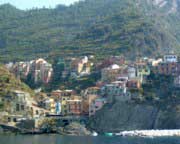
The handiest airports for this stretch of the Italian Riviera are Genoa and Pisa – both towns are connected by rail to the coast, and both are on budget airline routes from the UK.
Each of the five villages has its own train station, and trains stop at all of them roughly once an hour. Some of the trains passing through don’t stop; others stop only at one or two villages – so study the timetables carefully. Connections with the rest of Italy are good; this stretch of track is on the Pisa – Genoa mainline, although you may need to change at a nearby station such as La Spezia.
Get around the Cinque Terre
The three main modes of transport in the Cinque Terre are foot, train and boat. Passenger ferries link the villages at frequent intervals (and less frequently they also run to Portovenere); while the trains provide an extremely quick way of getting from one to another (stations are only a few minutes apart). Corniglia is the least accessible; boats don’t stop there, and the station is a bus-ride or steep climb from the centre. Walking is of course what most tourists come here to do; the main coastal path between the villages can be managed in around five hours – see our Walking the Cinque Terre page for a personal view. Those inclined to avoid steps and steep slopes should think hard before visiting. Local buses run within each village, but do not connect the settlements with each other.

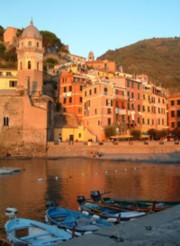
Accommodation in the Cinque Terre, Levanto and La Spezia
See Italy Heaven’s selection of accommodation in the Cinque Terre, Levanto and La Spezia area, along with links for easy online booking, and our review of the La Spezia hotel we stayed in. Or use this link for a full search of options, with availability and prices and the latest guest reviews
> Find hotels, B&Bs, apartments and villas in the Cinque Terre
On this site
Useful links
